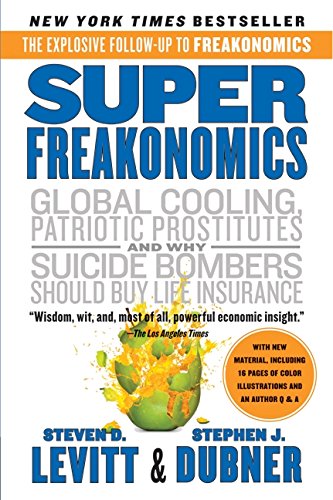Book Review: Superfreakonomics
Published:
Steven Levitt and Stephen Dubner’s sequel, Superfreakonomics, is as interesting and insightful as the prequel. Despite covering everything from prostitutes to global warming, the two Steves have the same underlying message: people respond to incentives in unexpected ways.

Here’s the paperback and audiobook.
Utility: ⭐⭐⭐⭐ (4/5)
Levitt and Dubner walk the talk. Their commentary really does shed light on the hidden side of various topics. Their specialty is explaining economic concepts—collective action problems, demand and supply, altruism—in practical, everyday contexts. However, to appeal to a broad audience, they seem to hold back from delving too deep into the details and generalizing concepts.
Writing: ⭐⭐⭐⭐⭐ (5/5)
Dubner (and Levitt too, I’m sure) is an amazing writer. The stories are delicately interwoven and connected, despite often literally taking place oceans apart. As economists too, they masterfully embed data and reasoned arguments into their stories. Easily one of my favorite books to read for pleasure.
Notes
Supply and Demand
Prostitutes in the south side of Chicago have offered their services for over a century, even though the law bans “turning tricks.” The women aren’t serving Satan—they’re just responding to supply and demand. Prostitution, particularly under a pimp, provides relatively stable and generous income, and even more so for high-end escorts. Detailed studies of South Chicago prostitutes reveal that law enforcement is usually rare and sometimes cooperative (hint hint). Given the incentives at play, the real question why more girls don’t enter this line of work.
Patterns
You need data to spot patterns. Many of them are unexpected. If you analyze the birthdays of top soccer players, you’ll find that they cluster right after the cutoff date for children’s leagues. The oldest children, even if by only 11 months, have a substantial physical advantage that grows over the years and they recieve preferential treatment. Similarly unexpected patterns include birth disabilities linked to pregnant Muslim women fasting during Ramadan and the upper-middle class backgrounds of most terrorists. Some people leverage pattern-seeking in their work, such as the patient information platform Azyxxi and the terrorist classification system based on banking behavior.
Altruism
Did 38 law-abiding citizens passively observe the hour-long murder of Kitty Genovese? Uh, no. Most were unaware of the murder, many called out, and one even called the police. The headline was a self-interested quote from the police chief. So perhaps crime isn’t driven by civic apathy. It does seem to be significantly associated with the introduction of TV. The underlying mechanism isn’t clear. Altruism also doesn’t seem to stand up in the lab. Variants of the Dictator and Ultimatum games by John A. List show that people are much more self-interested that you might expect.
Simplicity
Sometimes, the answer really is right in front of you. In mid-19th-century hospitals, many mothers died during childbirth from puerperal fever, but only if they gave birth in a hospital. Ignaz Semmelweis identified the culprit: doctors were performing autopsies on corpses and delivering children without washing their hands in between. Similar stories are in progress today. Children’s seats are expensive and tacky. And, in the lab, they aren’t any safer than a seat belt alone. Similarly, expensive hurricanes could be dispelled with a relatively cheap device called the salter sink—if only governments would dare fund it.
Externalities
Global warming is a serious problem. It is also the product of externalities. A coal plant doesn’t feel the full costs of the pollution it emits. Conventional solutions that rely on countries curbing emissions are too hopeful. There simply isn’t any reason for Russia or Saudi Arabia to cut back on oil production. But simpler solution may exist. Nathan Myhrvold and Ken Caldeira from Intellectual Ventures suggest that injecting the atmosphere with sulphate could cheaply increase the reflectivity of the atmosphere, reversing the effect of global warming.
Microeconomics
Homo-economicus? Maybe not. But what about Cebidea Cebinae, the capuchin monkey? In a Yale lab, Laurie Santos and Keith Chen taught these monkeys to use coins to purchase food. When they changed the prices of foods, the monkeys responded as if they had a convex demand curve—as expected. But then, the monkeys undertook a robbery of coins and began to use coins to purchase prostitution—as, I suppose, expected.
